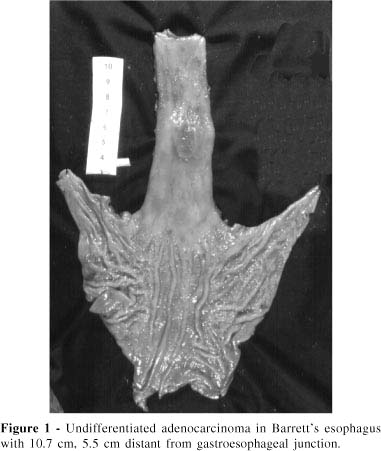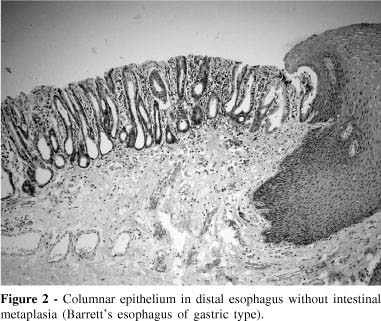Barrett's esophagus is the substitution of squamous epithelium of the distal esophagus by columnar epithelium. Intestinal metaplasia in Barrett's esophagus is considered to be the main risk factor for the development of adenocarcinoma. Diffuse adenocarcinoma and Barrett's esophagus without intestinal metaplasia are rare, and reports on the subject are scarce. PURPOSE AND METHOD: To estimate the prevalence of adenocarcinoma in 297 patients with Barrett's esophagus, during the period of 1990 to 2002, and in 13 patients undergoing surgery, to conduct detailed macroscopic and microscopic analysis, with performance of immunohistochemical tests for p53 and Ki67, correlating the type of tumor with its adjacent epithelium. RESULTS: In our patients with Barrett's esophagus, there was a prevalence of 5.7% of adenocarcinoma. The tumors developed only when the Barrett's esophagus segment was long (>3.0 cm). Tumors were located close to the squamous-columnar junction. The histological study revealed 2 patients (15.4%) with Barrett's esophagus adjacent to a tumor with gastric metaplasia without the presence of intestinal metaplasia. Tumors were classified according to Nakamura's classification (23% differentiated pattern, and 77% undifferentiated pattern) and to Lauren's classification (61% intestinal and 39% diffuse). The difference is due to the migration of microtubular and foveolar tumors of undifferentiated (gastric) pattern in Nakamuras classification to the Lauren's intestinal type. The immunohistochemical test for Ki67 was strongly positive in all the patients, thus evidencing intense cell proliferation in both the columnar epithelium and tumor. Expression of p53 was negative in 67% of the adjacent columnar epithelia and 42% of the tumors, without any correlation between the tissue types. CONCLUSION: Adenocarcinoma develops from mixed columnar epithelium, either intestinal or gastric, showing both the gastric and the intestinal patterns; thus, tumors can also grow in columnar epithelium without intestinal metaplasia. Barrett's esophagus should be followed up for the possibility of progression to malignancy, especially when the segment is longer than 3 cm.
Barrett's Esophagus; Gastroesophageal Reflux; Esophageal Neoplasia; Adenocarcinoma; Immunohistochemistry








